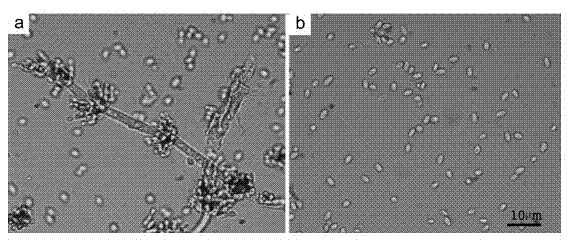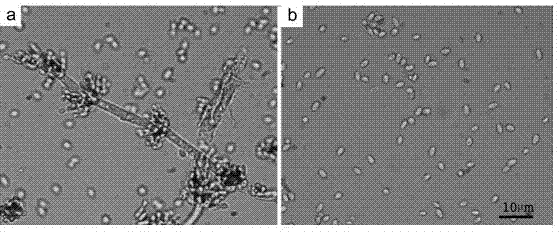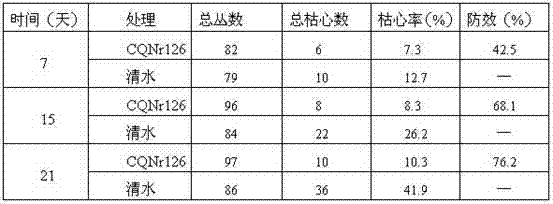Nomuraea rileyi strain, and application thereof
A technology of Nomura bacteria and strains, applied in application, fungi, biocides, etc., can solve the problem of lack of high insecticidal activity, and achieve the effects of good production traits, strong sporulation ability and strong insecticidal activity
- Summary
- Abstract
- Description
- Claims
- Application Information
AI Technical Summary
Problems solved by technology
Method used
Image
Examples
Embodiment 1
[0016] Example 1 Isolation of bacterial strains
[0017] Disinfect the surface of the collected naturally-infected rice leaf roller worms with 70% alcohol, put them in a 25°C incubator for 3-5 days, and make fresh spores grow on the surface of the insects; under sterile conditions, Use an inoculation loop to pick a small amount of fresh spores and streak them on a Sabouraud malt agar (SMAY) medium plate containing 100 μg / ml ampicillin; turn the streaked culture dish over and place it in a 25°C incubator for cultivation; 3— After 6 days, select the typical colony without miscellaneous bacteria, pick up a small piece of culture medium with hyphae at the edge of the colony, transfer it to the center of the culture medium on the slant of the test tube, and cultivate it at a constant temperature of 25°C for 15 days.
Embodiment 2
[0018] Embodiment 2 strain identification
[0019] (1) Morphological identification
[0020] The isolated CQNr126 strain was inoculated on Sabouraud Malt Agar (SMAY) plates, and cultured at 25°C to observe the morphological characteristics of the colonies, the sporulation structure, and the shape and size of the spores. The results showed that the colonies grew slowly and densely on the malt juice agar. The colonies were light green at the beginning of the culture, then dark green and colorless on the back. Aerial hyphae smooth with septa, 2-3 μm wide. Conidiophores are upright, separated, produced from substrate hyphae, 150-180 μm long, 2-2.5 μm wide, 3-4 wheel-shaped branch clusters, 2-3 phialides are closely attached to the branches, smooth , transparent to green. Bottle stem 4.7-6.5 × 2.5-3μm, mostly short columnar ( figure 1 a). The conidia are broadly oval, smooth, grass green in piles, and the size is 3.5-4.5 × 2-3 μm ( figure 1 b). Judging from the above c...
Embodiment 3
[0024] Example 3 Indoor insecticidal activity of CQNr126 against rice leaf roller and rice stem borer
[0025] Collect mature spores of CQNr126 cultured on Sabouraud Malt Agar (SMAY) plates, disperse them with 0.05% (W / V) Tween-80, and make a final concentration of 1×10 8 spores / ml suspension. The larvae of rice leaf roller and rice stem borer were spot-dropped, and each test worm was dripped with 2 μl of medicine with a micro-spotter, and 30 larvae were inoculated. After inoculation, they were reared under the conditions of room temperature 25°C and humidity 50-70%, set 5 repeated, with water as the blank control. Record the number of dead insects, calculate the survival rate, and obtain the fungal LT by statistical analysis of DPS2000 software 50 (when lethal).
[0026] Table 1 Insecticidal activity of CQ Nr126 strain against rice leaf roller and rice stem borer larvae indoors
[0027]
[0028] 5-7 days after inoculation, the larvae of rice leaf roller and Chilo sup...
PUM
 Login to View More
Login to View More Abstract
Description
Claims
Application Information
 Login to View More
Login to View More - R&D
- Intellectual Property
- Life Sciences
- Materials
- Tech Scout
- Unparalleled Data Quality
- Higher Quality Content
- 60% Fewer Hallucinations
Browse by: Latest US Patents, China's latest patents, Technical Efficacy Thesaurus, Application Domain, Technology Topic, Popular Technical Reports.
© 2025 PatSnap. All rights reserved.Legal|Privacy policy|Modern Slavery Act Transparency Statement|Sitemap|About US| Contact US: help@patsnap.com



